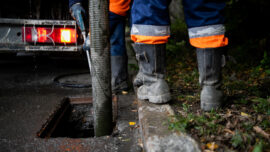Manchester Drain Unblocking Services
Introduc tion:
tion:
Drain unblocking in Manchester is a constant battle, due to heavy rainfall being common. This causes drainage issues become prominent more quicky and can disrupt daily life for homeowners and businesses alike. In this blog, Watermains and Drains UK explore the causes of blocked drains and provide practical solutions to keep your drains flowing smoothly.
Common Causes of Blocked Drains:
- Foreign Objects: Items like wet wipes, sanitary products, and cooking grease should never be flushed down the toilet or poured down the sink. These can accumulate and cause blockages.
- Tree Roots: Tree roots can infiltrate drain pipes, leading to clogs. Regular maintenance and root cutting are essential to prevent this issue.
- Collapsed Pipes: Old or damaged pipes can collapse, obstructing the flow of wastewater. Professional inspections can identify such issues.
- Heavy Rainfall: Manchester’s weather can overwhelm drainage systems during heavy rain. Blocked drains may result from debris washed into the pipes.
- Incorrect Pipe Installation: Poorly installed pipes can lead to blockages. Proper installation ensures efficient drainage.
Solutions:
- Professional Drain Unblocking Services:
- WMD operate in and around Manchester specialising in drain unblocking to keep customers flowing. We use high pressure water jetting techniques to clear blockages quickly and effectively.
- Look for fixed-fee services with no hidden charges or hourly rates.
- Regular Maintenance:
- Schedule routine drain inspections to identify potential issues before they escalate into costly repairs.
- Consider CCTV drain surveys to assess the condition of your pipes.
- Avoid Flushing Inappropriate Items:
- Educate household members about what can and cannot be flushed down the toilet.
- Dispose of cooking grease properly (e.g., in a sealed container).
- Root Cutting:
- If tree roots are causing blockages, WMD undertake root cutting & remedial solutions.
- Regular root maintenance can prevent future issues.
- Emergency 24/7 Services:
- Some companies offer round-the-clock call-out services for urgent drain problems.
- Having a reliable contact for emergencies is crucial.
Choose a Trusted Local Company:
When dealing with blocked drains in Manchester, choose a reputable local company with a transparent track record of excellent service. Remember that prevention is better than cure, so invest in regular maintenance to keep your drains clear and avoid costly repairs.
Remember, if you encounter a blocked drain, don’t panic. Contact WMD who will promptly to resolve the issue. Whether it’s a stubborn blockage or routine maintenance, addressing drainage problems promptly will save you time, money, and stress.
See what your local water authority – United Utilities say about helping to prevent blockages.
If you would like more information or have any questions, please don’t hesitate to contact the WMD team where we happily help to get customers drains flowing again.










